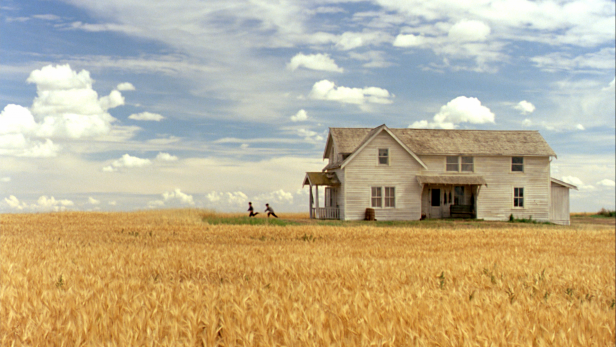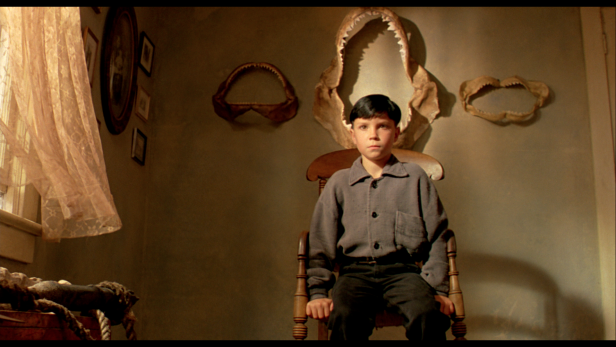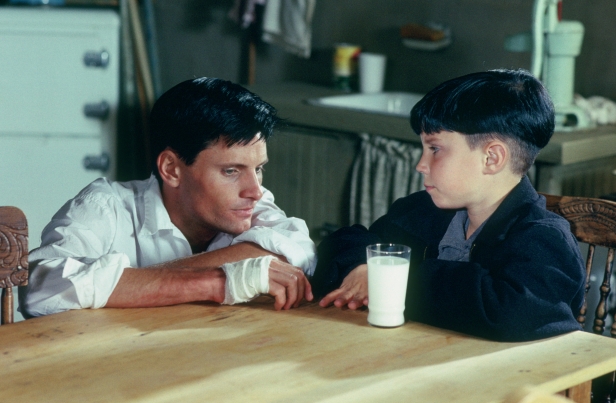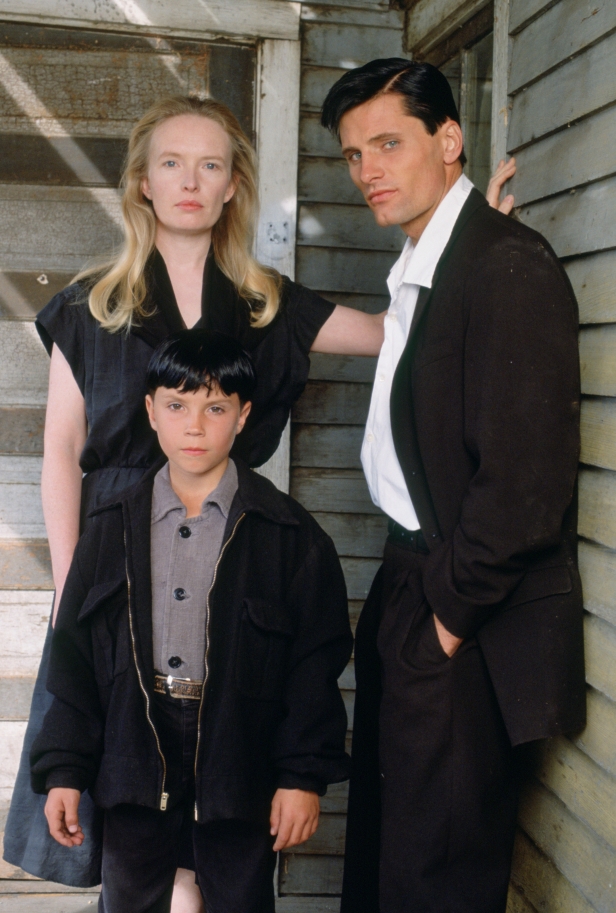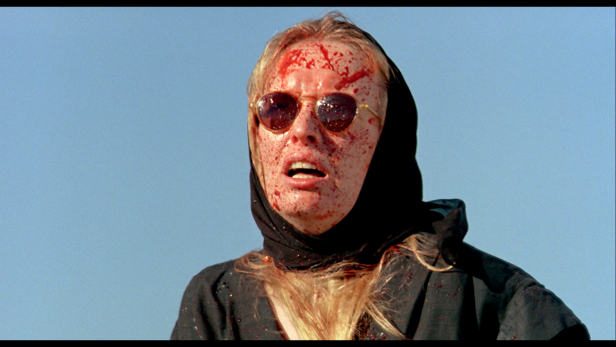Philip Ridley may just have three films to his name but anyone familiar with the writer-director’s work will tell you just how special his small but unforgettable back catalogue is. Arguably better known as an author (for adults and for children) and playwright (Mercury Fur, Piranha Heights, Radiant Vermin) than a filmmaker, Ridley’s The Reflecting Skin, The Passion Of Darkly Noon and Heartless form a loose trilogy of dark fairytales, of which the first is the finest.
The Reflecting Skin is a nightmare set in the bright yellow wheat fields of the American mid-West, where young Seth Dove and his family are waiting for his brother Cameron (Viggo Mortensen) to come back from the war. When children start going missing, Seth’s suspicion falls on his neighbour Dolphin Blue (Lindsay Duncan), an English widow who he believes to be a vampire. As the body count rises, the atmosphere grows ever more claustrophobic, and we start to wonder just who the monster is…
It was long considered to be lost, at least as far as a high-quality restoration was concerned, so it’s wonderful to see Soda Pictures’ glorious Blu-ray release of the film, which brings those incredible colours to vivid life. To celebrate its release, we had the chance to talk to Ridley about the film, his career, and why he’s done with filmmaking.
You mention the importance of Andrew Wyeth paintings on the Blu-ray, was that the starting point for the film?
That’s one of them, yeah. I started painting at St Martin’s School of Art, and one of the things I did there was a long sequence of photographic collages called American Gothic that were all what I gleaned to be a sort of mythical America. I hadn’t been to America when I was doing them but they were all based on films and images that I’d seen, so they were set primarily in the wheat fields because that’s Little House On The Prairie and all that kind of thing, and all the men looked like Elvis Presley and all the women looked like Marilyn Monroe. And as I was working on that friends of mine at the college were saying “You could put them together, they’re almost like a storyboard for some kind of surreal film about that landscape.”
Do you think the film would have been very different if you’d been to America?
I’d probably never have made it if I’d been and saw it, because the film isn’t about realism. Thank God! Right from the outset, I kept telling everyone look the film isn’t about realism; it’s about a dream. Whether it’s my dream, or whether you can say that it’s the dream of Seth himself as an older man looking back on his childhood. It’s about a dream world and it’s about fabulism.
And of course there’s the contrast between the brightness of the landscape and that darkness bubbling away underneath it…
That was one of the big challenges of the film, and what excited me about it, was to get a landscape that you would assume is going to be bright and cheerful. If you look at the ingredients on paper you would assume you were going to get the most joyful happy thing! Farmlands, three boys playing, endless wheat fields, blue skies! You would assume it was going to be like Mary Poppins in the wheat fields.
And to cinematically subvert that, to take that landscape and to do something that is playing against where everything is set, playing against the backdrop if you like, that is where I think the main dramatic conflict of the film takes place, that is its main alchemy.
I remember saying to [cinematographer] Dick Pope right at the beginning, our trick is to make these wide golden open expanses of wheat fields feel claustrophobic! If we can make them feel claustrophobic then we’ve won.
With the Cadillac like a shark…
Like a shark, I’m so glad you said that. We always referred to those as our Jaws moments, you know, that black shark moving through a yellow ocean.
Could you talk about the creation of Seth, this unreliable narrator?
Well, it was a long journey. First of all I made the decision that it was going to be solely through the eyes of Seth. It was part of the language of the film right from the outset, that not only are we seeing it through Seth’s eyes, not only is he an unreliable narrator, but also there’s something psychotic in the way that he’s remembering it. It was something that not many people picked up on when they initially saw the film because they’re saying “These bits are so over the top and these bits don’t make sense here,” yeah, I know that! These bits didn’t happen by accident! I didn’t by accident get a 70-piece string orchestra in! Oh my god, I just wanted to get a little low-key ukulele playing at this moment and suddenly this symphony orchestra!
They were planned because this is the way that Seth is seeing it. The idea of doing it, not just through a child, but perhaps an old man remembering his childhood and then filtering it through a psychotic sensibility is what The Reflecting Skin is all about.
The relationship between Seth and Dolphin is fascinating, you can see that she does try to connect with him and he completely misinterprets it.
Well, that’s the way that a child’s mind works, isn’t it? He’s made all his decisions about her before she’s arrived. And of course grown-ups are not really real to you as children, are they? They’re just these monsters really, these giants. We forget just how big these people must appear to us. As a grown up in comparison, you’re looking up at somebody who’s nearly 20 foot tall. They’re these giant monstrous kind of things and Seth is kind of every-person, because what he’s trying to do is desperately make sense of the world.
He’s desperately trying to piece together some elements of the narrative that he can form a comprehensive story, a story that makes sense, and the tragedy of the film is how he makes mistakes all along the line, he picks up on the wrong information, or the correct bits of information but joins the dots together in the wrong way. Hence the journey of the film. But I’m always wary because even describing the film like that gives it more logic than the film has! Because the film is psychotic, so it’s about a lot more than that really.
Was it difficult to convey that to the actors?
Yeah, it really was because all the performances are sort of in inverted commas. They’re all aware of what they’re doing. A couple of the trickiest things were with Jeremy [Cooper] who was playing Seth. He doesn’t act like a child acts in usual films. He doesn’t react to anything in the way that you’d expect the Hollywood child to react, but he’s reacting as children do react, which is like they’re just sponges, soaking all this up and just assimilating it.
He’s also playing a child that is a bit disturbed. There’s something not quite right with Seth, he’s been brought up in this ostensibly very golden wonderful landscape but he’s in this deeply religious segregated part of it. His connections with other people have been limited. The one thing I kept on saying when we were on set if it got wrong was “No, it’s getting too cute! It’s getting too cutesy! This is not about you being a cute kid; this is you being a monster! This is Lord Of The Flies in the wheat fields; this is not Little House On The Prairie!”
What was the experience of shooting in those wheat fields like?
Well, it was stressful in that a lot of what we were fighting against was out of our control. You can meticulously work something out and the weather turns against you. And the weather was turning against us consistently on the film. I’d already made my life, and everyone’s concerned really, very difficult because I’d decided to shoot everything during the day during the magic hour period, that whole Days Of Heaven look, with the sun about to sink on the horizon, where the shadows are longest and the light is really golden. So we only had about three hours at the most of the day that we could shoot in anyway.
So we had this routine of turning up very early, rehearsing all the set-ups for the whole day, we would go through absolutely everything shot by shot, meticulously worked out, have lunch and then shoot like fury through the afternoon to get everything done. And you can bet your bottom dollar that as soon as we set up the first thing the clouds would come and it would be overcast and it would start raining.
How did you find the reaction to the film?
The initial reception was overwhelming, it was a huge festival hit. It was an official selection for the Cannes Film Festival and they had to put on extra screenings for it. I remember walking across the foyer two minutes after the film had screened and one of the leading French film critics came up to me and said “Votre film est déjà un cult!” I think the problem when it was commercially released was nobody quite knew how to package this film. Was it a horror film? Was it a comedy? Was it a drama? Nobody knew how to release it and I think that the film suffered a great deal. People like their genres easily defined and if anything it’s got more like that over the last ten years.
It really does seem to have endured, people have been drawn to it.
I think time has in a strange kind of way time has caught up with it, because a lot of the things that seemed bizarre and difficult to take on board with the film when it first came out are not so difficult to grapple with now. The way that it deliberately breaks the narrative structure, that you think you’re doing one story and then it becomes something else and then not everything is explained…The foetus comes in and that’s never really explained one way or another. That was a huge problem for people!
The Reflecting Skin is about the meeting place between the film and the audience. The film gives you a sequence of dilemmas and questions like light through a prism, it refracts all this light in different directions and it’s up to the audience to piece that together into something that makes sense for them. It’s not normal or accepted narrative storytelling. It just gives you a series of dilemmas and clues and hints and then the alchemy, the magic happens in how you react to that. You’re getting all this different information, the images are telling you one thing, the music is telling you something else. The dialogue, which is this arch, remembered dialogue, it’s not meant to be the real way that anyone spoke if it really happened. It’s how an older Seth is remembering this dialogue as everything being deeply significant; everything is carrying an ulterior message. It doesn’t spoon-feed you anything at all.
On the Blu-ray you describe this, Darkly Noon and Heartless as a trilogy
Yeah, it’s kind of ended up working out like that; I obviously didn’t have some kind of master plan 25 years ago! It’s just strange the way that that’s worked out, they share so many things really. They’re all first person narratives so they’re all through the eyes of one person, and they’re all about somebody that’s trying to make sense of the world about them. And they’re all debates on memory, loss, faith, all of these things.
So yeah I think they do work together, and you know there have been screenings of them done as three films at various little underground screenings, all given various titles. It’s like the same personality haunts all of those films. Darkly Noon, the Brendan Fraser character Darkly, could almost be Seth grown up. And certain images appear in all of them. Fire appears in all of them. Lots of things get burnt in my films. I can’t see something without trying to strike a match! Let’s set that on fire!
Do you have any ideas for a fourth film?
No, I’m never going to make another film. Never, it’s just…[laughs] I’ve made three and I think that’s going to be it really because it’s, God there’s so many adjectives I’m groping for and none of them don’t involve blasphemy so I don’t know where to go! But it’s just…it’s just a fucking nightmare basically, the whole thing. I hate this thing where it’s so much out of my control once a film is finished. You don’t know who owns the rights, people can sit on films and do nothing with it, there’s no other art form that exists in this way, that somebody can have complete control over your creation and decide to do absolutely nothing with it. And with everything else that I do the copyright stays with me and I can get it out there and even if nobody else wants to do it I can still get it out there myself.
But the films, we’re going through this with The Passion Of Darkly Noon, so much is tied up with contractual quagmire and all of that that you find that’s where most of your energies are going. I think Soda have done an incredible job in rescuing this film and getting it back because it obviously took a lot of work to do that. But oh no, film, oh gor blimey. I mean, I’d love to, don’t get me wrong, I’m not saying I don’t like making films. The happiest moments of my life have been when I’ve been on set filming and I love working with actors, but afterwards it’s in the laps of the powers that be.
Finally, did you have any idea that the exploding frog would be such a big talking point?
I thought it might get a bit of attention but I had no idea! I thought there were so many other bits in the film that were going to become the big iconic moments. When we did the first screening at the Cannes film festival, the moment that that happened you could see the journalists in the audience already writing their reviews! [laughs] So the exploding frog happens and then they’re not looking up, they’re just looking down at their notepads, writing.
I think what happens is because you work on a script for so long and then you’re filming it for so long, you kind of get a bit disconnected to how much impact certain things might have. So by the time that we ended up shooting that and doing that it seemed to me like the most perfectly natural thing in the world that three kids would get together and explode a frog! It’s one of the main things I’m asked about no matter where I go and no matter about what I’m doing. I’m out in Tokyo doing my latest stage play and people are coming up to me going “The exploding frog…”
So yeah, it’s odd what sticks, isn’t? It was also the greatest fun section to do in the film. Probably not for Lindsay Duncan, bless her heart, who had to get a face full of blood but the kids had the best day ever doing that. They just thought it was hilarious, they really thought it was just the funniest thing they’d ever seen in their life.
The Reflecting Skin is released by Soda Pictures on Blu-ray on 30 November, and you can buy it here. Keep up with the latest genre news with the new issue of SciFiNow.
